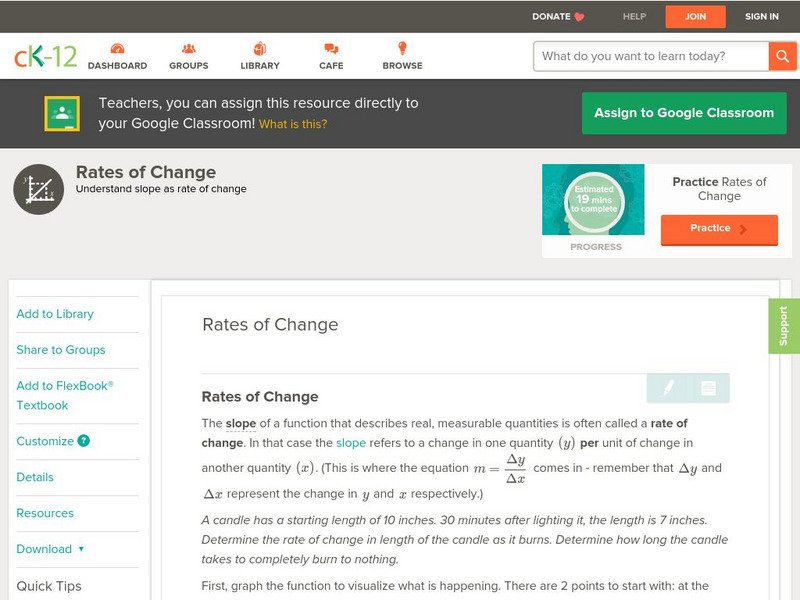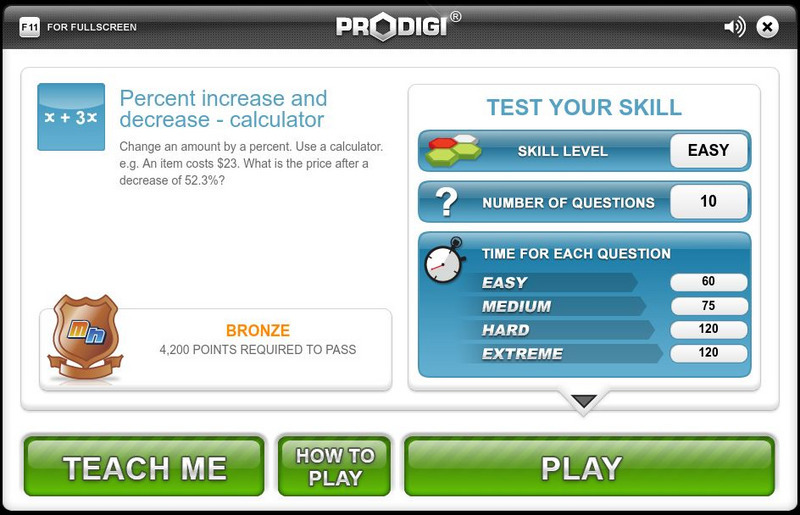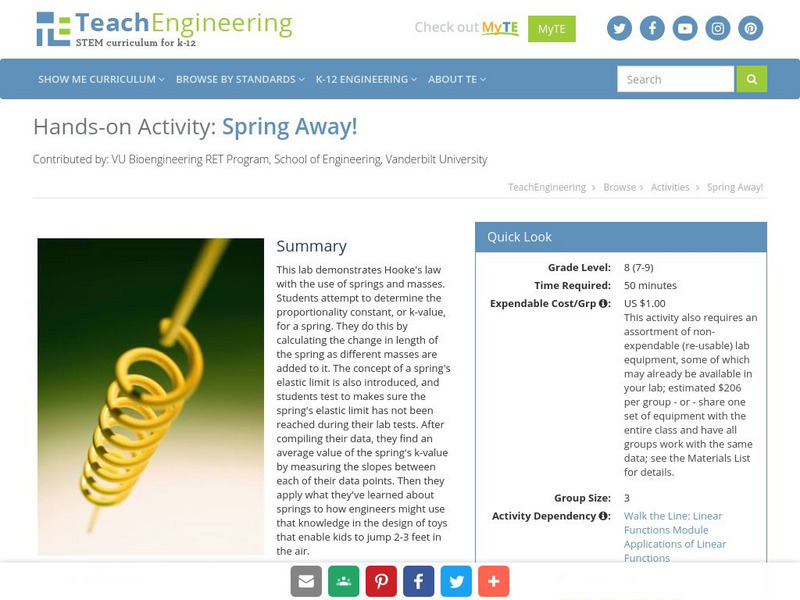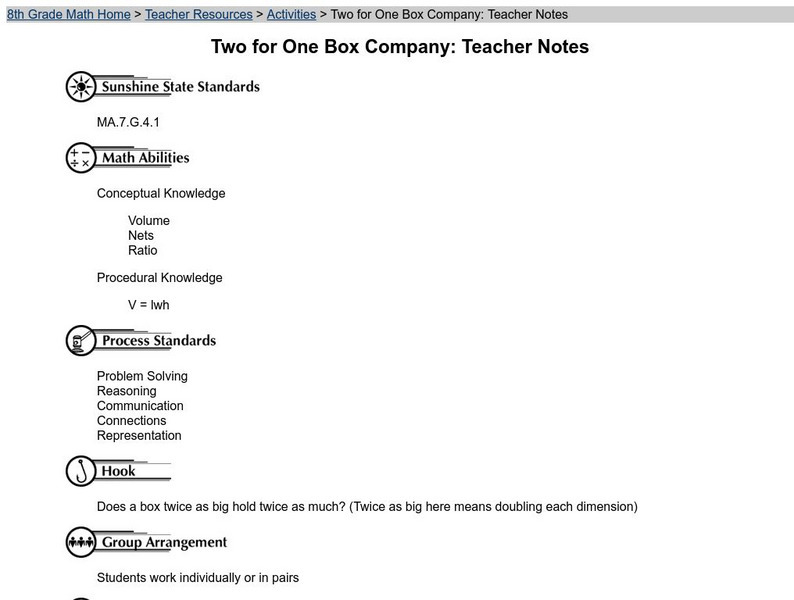Texas Education Agency
Texas Gateway: Determining the Effects of Proportional Change on Perimeter
Given pictorial representations and problem situations involving perimeter, the student will describe the effects on perimeter when dimensions are changed proportionally.
Texas Education Agency
Texas Gateway: Direct Variation and Proportional Change
The student will use a variety of methods inculding tables, equations and graphs to find the constant of variation and missing values when given a relationship that varies directly.
McGraw Hill
Glencoe: Self Check Quizzes Percentages and Proportions
The five question question assesses learners on percentages and proportions. Hints are available to help students solve the problems.
CK-12 Foundation
Ck 12: Algebra: Rational Equations Using Proportions
[Free Registration/Login may be required to access all resource tools.] Learn how to solve rational equations using proportions.
Khan Academy
Khan Academy: Graphing Proportional Relationships
Students work with rates of change to graph proportional relationships. They receive immediate feedback and have the opportunity to try questions repeatedly, watch a video, or receive hints.
PBS
Pbs: The Lowdown: The Math of Trash: Percents and Proportions
Discover how percents and proportions help explain issues like climate change, composting, and zero waste in this video from KQED. In the accompanying classroom activity, students estimate the percentage of various types of trash that...
Khan Academy
Khan Academy: Rates and Proportional Relationships
A variety of questions about rates and proportional relationships involving graphs, tables, and equations. Students receive immediate feedback and have the opportunity to try questions repeatedly, watch a video, or receive hints.
Other
Nearpod: Percent of Change
In this lesson, 7th graders will learn how to solve percent of change problems.
Department of Defense
Do Dea: The Law of Exponential Change
If you are a budding environmental scientist, archeologist. physical scientist, or bacteriologist, then this is the site is for you. You will be looking at the differential equation of proportional change and how it is related to the...
Google
Google for Education: Percent Change
Students analyze proportional relationships and use them to solve real-world and mathematical problems. Here, look for patterns to understand and solve percent change problems.
PBS
Pbs: Real World Proportional Relationships: Gender Wage Gap
Using this infographic, learn how wage equity today compares with data from 50 years ago, at the dawn of the equal pay movement. The accompanying classroom activity invites students to explore the change in the gender wage gap from 1965...
Other
Gartner: 10 Ways Technology Will Change What It Means to Be Human
An article from Campus Technology magazine that discusses how technology is changing the human condition and many of these changes are driven by the wants, needs, and interests of people. For example, artificial emotional intelligence...
PBS
Pbs: The Lowdown: Exploring Changing Obesity Rates Through Ratios and Graphs
In these KQED Lowdown infographics, explore how adult obesity rates in the United States, as measured by body mass index (BMI), have dramatically changed in the past half-century. A circular graph and a pictograph depict data by decade,...
Mangahigh
Mangahigh: Number: Percent Increase and Decrease No Calculator
Students learn about the concept of percent change by exploring a tutorial. They can then test their knowledge by taking a ten question assessment that increases in difficulty as they correctly answer questions.
Mangahigh
Mangahigh: Number: Percent Increase and Decrease Calculator
Students learn about the concept of percent change by exploring a tutorial. They can then test their knowledge by taking a ten question assessment that increases in difficulty as they correctly answer questions.
Other
Desmos: Marcellus the Giant
Students explore proportional relationships in this activity as they create a giant that is proportional to an original model. The proportions are graphed and students can interact with the graph to change the giant's size.
Department of Defense
Do Dea: Algebra 1: Semester 1: Equations
A learning module through which students learn about equations including the following: Translating words into equations and equations into words, The Properties of Equality to help solving equations, Techniques for solving simple...
Cornell University
Cornell University: Art, Design, and Visual Thinking
Use the left-hand toolbar of this site to investigate an online textbook for the language of design. It provides visual examples and explanations of line, form, color, color psychology, texture, balance, proportion and many more...
TeachEngineering
Teach Engineering: Spring Away!
This lab demonstrates Hooke's Law with the use of springs and masses. Students attempt to determine the proportionality constant, or k-value, for a spring. They do this by calculating the change in length of the spring as different...
PBS
Pbs Learning Media: Atmospheric Oxygen
In this feature, adapted from Interactive NOVA: Earth, students explore the relationship between oxygen concentration and the well-being of various organisms by simulating a change in oxygen levels and observing what happens.
Other
Desmos: Put the Point on the Line
In this activity, students investigate slope and how it can be explained as a ratio of change between the vertical and horizontal coordinates.
Department of Defense
Do Dea: Growth and Decay
Practice problems that each illustrate a different use of the Law of Exponential Change. Examples and explanations are provided. Great review for the AP Calculus test!
Arizona State University
Asu: Chicana and Chicano Space
Provided by Arizona State University, this website is a comprehensive thematic, inquiry-based art education resource. Includes two interdisciplinary units of lessons.
University of South Florida
Fcat: Two for One Box Company: Teacher Notes
At this site learners use proportions to explore how volume is effected by dimension changes. This hands-on activity can be done individually or in pairs.














